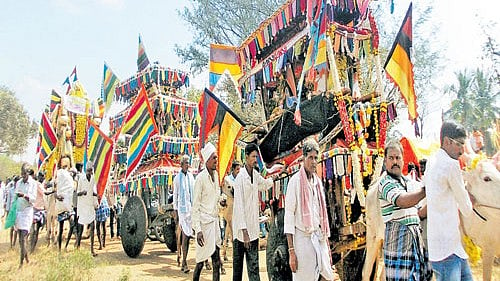
Chariots from different villages being taken for Doddammathayi Jatre (fair) popularly known as 'Bandi jatre', in Kestur
In the late 1960s, I fondly remember the bustling santhe (market) on Salagame Road in Hassan. Every Tuesday, rain or shine, the road would transform into a vibrant marketplace, stretching from Saint Joseph School junction to the gates of Engineering College. Farmers, villagers, traders, and people from all walks of life, including women, would gather on both sides of the road, showcasing their produce.
The gate of the Government College and the wide spaces on either side were prime spots, and sellers vied for them. An array of fresh produce was on display, including vegetables, various types of soppus (greens), tubers, and creepers. Despite their affordability, some people still bargained. As you ventured further, you’d notice sellers offering domestic utensils and implements essential for agriculture. Additionally, skilled artisans were busy fixing shoes for bullocks and horses.
Like many children, I too relished visiting the santhe. There were village folk selling butter in earthen pots. We’d taste the creamy butter floating in buttermilk, and sellers would enthusiastically shout, “Cow’s butter!” or “Buffalo’s butter!” If you were skilled at bargaining, you could buy more for less money. There were seasonal fruits also available. The whole road on Tuesday’s would see a fairytale-like transformation, and by late afternoon everything would disappear.
The santhe was a sensory delight, especially during the rainy season, when people would gather under black umbrellas and gunny bags. By late afternoon, the market would wind down, only to reconvene the following Tuesday.
In nearby Chickmagalore, the santhe took place on Wednesdays, adjacent to the vast Dantaramakki tank. Our school closed on Wednesdays and worked full days on Saturdays, allowing me to explore the market at leisure, much to my delight. This santhe was known for its wide array of fresh vegetables, fruits, cereals, pulses, and essentials. Sellers would loudly announce prices, and some even sold fish, meat, and festival goodies like clothes and sweets. Sugarcane vendors would peel and cut the sugarcane into bite-sized pieces, while watermelon and other seasonal fruits were abundant. We’d savour juicy guavas and plantains at throwaway prices. Those Wednesdays were a treat, as I’d walk from Vijayapura to the market, buying fresh produce and returning home before lunch. This was our weekly routine.
Years later, visiting a massive mall in Bengaluru, I couldn’t help but reminisce about those vibrant santhes. While the mall offered everything under one roof, it couldn’t replicate the charm and essence of the santhe. The santhe remains etched in my memory as a symbol of community, vibrancy, and joy.